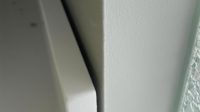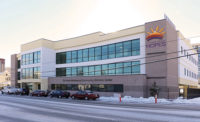This article appears courtesy of NWCB
The performance of a building, and the interaction with the architectural finishes that it supports, have been perplexing issues that the AEC industry has faced for many years. In a perfect construction world, we would be able to design and construct a building that could stand on its own with standard detailing that connects everything together starting at the roof to the walls to the foundation. Unfortunately, this is not the case as the structure is going to experience active live loading by the occupants on the floors, exposure to temperature differentials from the environment and motions due to wind and/or seismic activity during the life of the building. These events cause vertical and horizontal movements that must be addressed to prevent cracking, etc., in the exterior and interior finish systems. Generally, these issues tend to happen after all construction crews have moved on to the next project and require subsequent efforts to repair that are probably not budgeted in the original project fee (i.e., out of pocket expense to correct).
One misconception is that the finish systems must be tied to the base structure so it will move with the building during horizontal and vertical movement events. The real intent is to provide connections to the structure that allow the building to move while the finish system stays in its original location. This helps alleviate potential cracking/compromising of the exposed elements.
Industry Developments
Our industry has fortunately developed products to address these issues and provide solutions to previously difficult framing conditions. There are connectors made that allow for vertical and/or horizontal structure movement. These connectors are used at areas where jointing is being provided in the finish and framing systems.
Let’s take a moment and recognize the jointing types that are referenced in the field and on construction documents:
1. Control Joints
These are located in the finish system only (i.e., stucco, EIFS, etc.). Their intent is to provide relief locations for the system based on the amount of exposed surface. There is no special structural joint in the framing system behind the finish.
2. Expansion Joints
These are provided at locations where a separation is required in the finish system and the structure support framing. These are oriented both vertically and/or horizontally.
3. Drift Joint
These are a complete separation system, horizontally along the building framing, allowing horizontal movement between building levels without creating a tearing effect in the finish system. These joints are used predominately in high seismic zones. The drift joint is designed to provide more horizontal movement than the typical finish will allow. The different drift systems are also dependent on the structural framing of the main structure.
4. Crush Zone Jointing (needed in high seismic locations)
These joints are needed at locations where perpendicular walls connect. During a seismic event, one wall is moving in a horizontal direction and will collide/crush the perpendicular wall elements/finishes unless some form of relief is provided (i.e. jointing). This is an item the industry is now trying to consider as past building earthquake performance has indicated that more attention to detail must be paid in high seismic locations to alleviate building intersection damage.
The design architect and structural engineer must take into account these issues and coordinate the need and placement of joints as part of the architectural finish. Structural framing layouts and where they occupy space in relation to the wall framing systems are extremely important.
If a system is laid out where a floor-to-floor stud framing condition must occur, options for joint layout are limited. The wall system and the structural framing system are in the same plane and are forced to move in plane and out of plane together. Framing around steel brace-frame elements is an area where these issues are surfacing. When the brace-frame members experience an out-of-plane loading, the wall finish may tend to crack in a pattern that follows the brace-frame members. Architecturally, it is challenging to have an acceptable finish jointing pattern at brace-frame locations. In typical buildings, jointing must occur at the floor/roof levels to be where the framing breaks occur. At times, this is not the most architecturally acceptable or preferred jointing layout for the final appearance of the building.
Jointing Layout Patterns
A bypass exterior framing system, relative to the structural framing system, allows more flexibility in jointing layout patterns. As the exterior framing is set forward of the structural members and floor slabs, it allows the light gauge framing to span lengths more than the floor-slab-to-floor-slab dimension. Extending the light-gauge stud frame past the floor slabs allows the system to move the joints away from the floor slab levels to a location where the visible jointing is desired. Joints can also be placed at the top of windows or curtain walls to provide better movement for the structure.
In closing, as a design/construction community, it is our responsibility to address the issues of structure movement and protection of finish systems from unacceptable performance for the life of the building early on in the project. When the finish system does not perform properly, building owners are not satisfied and the responsibility falls on our profession to develop a costly repair to rectify the situation.







